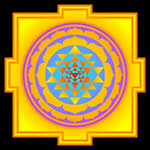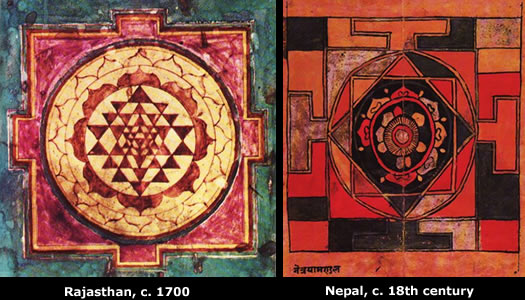|
|
|||
 |
|||
|
TATTOO DESIGNS & SYMBOLS - YANTRA TATTOOS
Tattoo Symbol Index - A B C D E F G H I J K L M N O P Q R S T U V W X Y Z Tattoo designs - WXYZ >> Yantra Tattoos
Yantra is a Sanskrit word comprised of yam (to hold the essence), and tra (instrument).
A yantra, like the mandala, is usually symmetrical, but different in that the design can be three dimensional. Both are meant to be a microcosmic picture of the macrocosm, designed so that the eye is driven to the focal point at its centre, which can act as a doorway to the 'Absolute'. The mind, once it's settled in this way, finds itself less able to continue its incessant internal monologue. In other words, a yantra is a way to 'quiet' one's thoughts of chatter and focus the mind on a single thought, or on a state of clear-mindedness or clarity - a state some consider to be a state of 'nothingness'. Eventually, even the object of concentration is abandoned, and the mind remains emptied, leaving pure awareness. Taken to the limit, practitioners of the yantric approach describe this mental state as a, 'union with God'. Yantras can be designed to summon specific deities. By tuning into a certain yantra, you can 'dial up' its specific deity and the creative force it represents. Note, however, that the yantra is only a mechanism for concentration. The expansion in consciousness doesn't come from the yantra itself, rather from 'the whole', from the universe, the macrocosm. A yantra's underlying rationale goes like this - every shape emits an energy pattern, or frequency. It's a science as well as an art. Hindus may be the first to have described the phenomenon, but other religions have taken advantage of it as well. Think of the Jewish people and the power of their Star of David, for instance. Of the Christians and the extraordinary power of the symbol of their cross. The Egyptians and their pyramids. The swastika, originally a nearly universal design across all of Asia and the Middle East, but one that was ultimately co-opted by the National Socialists, also known as the Nazis, in Germany. Different powers are said to emit from different shapes. Yantra Yoga employs only those vibes that are harmonious and beneficial. Creating a proper and effective yantra involves a ritual undertaken in a consecrated place. No surprise, then, that the Western world mistakes yantras as little more than simple or 'pretty' pictures. This is a gross oversimplification of the power and importance of the symbolism inherent in the design of a yantra. Yantra cannot simply be invented by a brilliant imagination, rather they are revealed by true spiritual teachers who are familiar with our moods and their associated energies and shapes. Just as a cross would not be a cross if it was inverted, so a yantra must not be viewed upside-down. In Cambodia, yantra tattoos date back to the times of Angkor, in the 9th to 15th centuries, AD. They were adapted by the Khmer upon the arrival of Buddhism from neighbouring India. Thought to inspire everything from good luck to longevity, they've been especially popular with people in dangerous occupations seeking personal protection. Soldiers are regular takers of yantra tattoos. These 'sak yant' tattoos are still popular today in Cambodia and Thailand, and are usually performed by Buddhist or Brahmin monks. The Wat Bang Phra temple in Thailand is famous for its mass tattooing of believers in the yantra tattoo. Animal spirits derived from pre-Buddhist shamanism have been incorporated into the Thai Buddhist 'sak yant' tradition.
The tattoo on Angelina Jolie's left shoulder is reported to be a yantra tattoo. Get inspired by some really great images and photos in our Yantra Inspiration Gallery See also: Religious Tattoo Index, Brahma Tattoos, Shiva Tattoos, Ganesha, Krishna, Kali, Shiva linga, Religious Tattoos Tattoo designs - WXYZ >> Yantra Tattoos Tattoo Symbol Index - A B C D E F G H I J K L M N O P Q R S T U V W X Y Z |
||
| Celeb Tattoos | Facts & Stats | Designs & Symbols | History | Culture | Links | Tattoo Galleries | Contact | |||
|
|
|||



